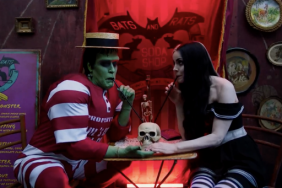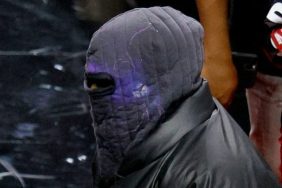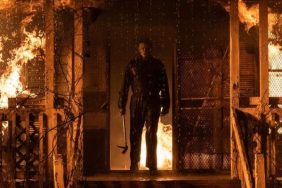Welcome back to the final chapter in The Series Project‘s coverage of the famous Halloween series. Eat some candy, and let’s dive in.
About the mask that Michael Myers wears: In both the 1978 original and the 2007 remake, the mask in question was a plain white, over-the-head rubber mask (with real hair!) that could be purchased in any old Haddonfield, IL costume shop. Within the Halloween universe, what do you suppose the mask was called when it was developed by the manufacturer? “Blank-faced ghoul?” Was it a paint-your-own kit of some sort? I know in the real world of the original 1978 production, it was a James T. Kirk mask painted white, but within the Halloween universe, I don’t think Michael stole a James T. Kirk mask and painted it white. No, that was a pre-fab mask with some sort of name or intent.
In Halloween 4, Michael is seen stealing a new, identical mask from a costume shop, meaning the mask was still in production a decade after the events of the first film. By then, I’m willing to accept that the manufacturer marketed it as a “Michael Myers mask” to exploit the serial killer’s deeds from a decade previous. That would mean that the real Michael Myers stole a mask that was eventually named after him. I wonder if Michael is aware of that. That a mask manufacturer is exploiting his image, and using his name. I doubt Michael Myers gave legal permission for his name to be used on this Halloween product. Michael could sue.
And if the mask is wisely on sale in all the local costume shops, and other people buy it and wear it from time to time (which happens on several occasions throughout the Halloween series), would Michael eventually tire of its ubiquity? Would he feel like a poseur for wearing it? And even if then he were to change masks (say, he switched to something from Silver Shamrock), could he cut himself free from his association with the original mask? Would the mask still be called a Michael Myers mask, even if Michael Myers was no longer wearing it?
This is the kind of stuff I think about when I’m up late.
But I digress. Let’s move onto the final two films in the long-running Halloween franchise. Last week, I talked about two different versions of Halloween: The Curse of Michael Myers, the intended final film in the franchise Halloween Water, and the actual final film in the original Michael Myers continuity, the pretty forgettable Halloween: Resurrection. This week, we’ll be looking at the two films in a new Halloween continuity, both directed by Rob Zombie, and both with a decidedly new tone. Let’s look to…

Halloween (dir. Rob Zombie, 2007)
Of the films to come out of the dreaded remake cycle of the ’00s, Rob Zombie’s Halloween is, I must admit, perhaps the best. This was not just an updated visual or idiomatic spin on the old material, but the work of an actual auteur who brought his own voice to the myth, changing it into something that was truly his own. That’s right: I just called Rob Zombie an auteur. Zombie, one-time frontman for several heavy metal outfits, has become a striking and noteworthy filmmaker in recent years. And while many of his films aren’t necessarily all that great (House of 1000 Corpses is pretty awful), he at least has a unique style all his own.
Zombie makes horror movies that all take place in a filthy, filthy world, caked with grime, dried blood, gut-churning panic, and extreme fear. Zombie (nee Robert Cummings) spent much of his youth in a traveling carnival, and he has pointed out in interviews that clowns and carnies are actually a greasy and dirty class of people, usually reeking of dried sweat, manure, car parts, unwashed costumes, and whatever they got drunk on the previous night. When he sees a scary guy in a scary outfit, he immediately thinks of these pungent drifter types he was raised with.
And so he did with Michael Myers. The remake of Halloween (hereafter Halloween R) is less concerned with the clean, mannered, inexplicable evil that Michael had in the 1978 original, and more concerned with the real-world traumas that would lead the young Michael Myers to murder. Halloween R is essentially an origin story that takes place in a new universe.

So we see the ten-year-old Michael Myers (Daeg Faerch) living at home with an abusive alcoholic step-father (William Forsythe), a moonlighting stripper mom (Sheri Moon Zombie, Rob’s wife), and a horny older sister. Michael is already something of a bad egg, as he likes to kill animals. He is eventually bullied and abused enough that, on Halloween night, he puts on a clown mask and murders his family members. The brutality and pain of the kills is emphasized in this version, and each kill is accompanied by a gut-wrenching sense of hopelessness for both the victim and the killer. The victims are truly afraid, and cry and shriek in nonsensical panic. These are not sensationalized killings. When Michael kills a topless woman in this movie, it is not titillating or fun. This is a sick, dark, hurtful, brutal, hopeless film.
In a weird way, it’s kind of a pity this had to be a Halloween movie. Zombie’s pretty darn realistic view of how a killer could actually come to be, and how messy and noisy his killings would actually be, is so down-to-earth, so practical, that the fact that our young boy will grow up to be Michael Myers almost robs him of his uniqueness. The fate of Michael Myers robs from his drama as a young boy. Had Rob Zombie just made a straightforward slasher movie with a new killer and a new myth, even with all the usual Halloween details in tact (the murdered sister, the holiday-themed killing), Halloween R would have perhaps been a more notable film.

We see the young Michael growing up in an institution, slowly growing more and more distant, and less and less communicative. Dr. Loomis (Malcolm McDowell) is back, trying to find out what this young killer is all about, and only finding a blank wall of increasingly mute and increasingly murderous rage. Michael has a thing for masks, and makes them in his cell. Soon, he’s wearing masks all the time. Fast forward 15 years, and Michael (Tyler Mane) escapes. How does he escape? A pair of rowdy orderlies break into his cell to rape a female patient in front of him, and he escapes when the door is open, but not before killing them a lot. Rape in front of a killer. See what I mean about Zombie’s penchant for filth?
A detail taken from Halloween II: Laurie is still Michael’s long-lost baby sister named Laurie. Laurie (Scout Taylor-Compton) is still the most innocent of her group, although she’s not the shrinking violet she was in the original. Her pal Annie, previously played by Nancy Loomis, is now played by Danielle Harris, who, if you’ll recall, played the young Jamie in Halloween 4 and Halloween 5.

Zombie’s greatest strength as a director is his ease with social circles. When people gather in a room to chat in a Rob Zombie movie, they all have an ease and a banter that implies they’ve known each other for a long time. There are in-jokes, bouts of playful sarcasm, and a friendly naturalness rarely seen in most movies, much less horror movies. This playful character-rich chatter only serves to highlight the eventual tragedy of these people’s violent deaths.
Zombie also likes to cast old-school horror icons and other notable actors in bit parts, and we see brief glimpses of Brad Dourif, Dee Wallace, Udo Kier, Richard Lynch, Sid Haig, Clint Howard, Leslie Easterbrook from Police Academy, Micky Dolenz, and Sybil Danning.

The final 30 minutes of Halloween R (which runs too long at 121 minutes) are essentially the entirety of the 1978 original, featuring all the stalking and killing we remember, all punctuated by the exact same music as before. Only now, the killings are sad, and seem like the tragic preventable result of abuse and trauma. Halloween R is less a horror film (although there is plenty of blood and gore), and more a cautionary tragedy about abuse and depression. It’s a darn good film. I just wish it wasn’t a Halloween movie.
Then, when Halloween R was successful enough, Zombie was asked to make another in the same continuity. What he came up with was… well, let’s take a look at…








